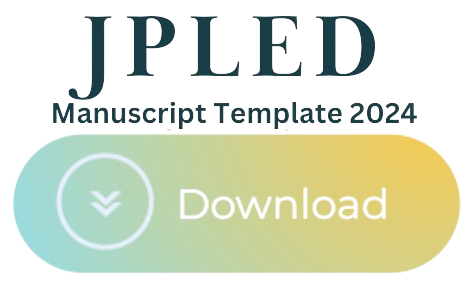Improving Pancasila Education Learning Outcomes Using the Problem Based Learning Model Assisted by Google Sites Media
DOI:
https://doi.org/10.58737/jpled.v5i2.504Keywords:
learning outcomes, pancasila education, problem based learning, google sitesAbstract
This research was motivated by the low learning outcomes of students in Pancasila Education, which was due to teachers not yet utilizing innovative learning models that could attract students' attention during lessons. The purpose of this study was to describe the improvement in Pancasila Education learning outcomes through the use of the Problem Based Learning model assisted by Google Sites media. This research was a classroom action research (CAR) conducted at SDN 17 Sungai Pandahan, Pasaman Regency, employing both qualitative and quantitative approaches. The study was carried out in two cycles, with Cycle I consisting of two meetings and Cycle II consisting of one meeting. Each cycle consisted of four stages: planning, implementation, observation, and reflection. The subjects of this study were the teacher and fourth-grade students of SDN 17 Sungai Pandahan, with a total of 20 students — 9 male and 11 female students. Data collection techniques included observation, tests, and non-test instruments. The results of this study were based on the recapitulation tables of the results from Cycle I and Cycle II as presented in the discussion section. The findings showed an improvement in: a) the teaching module, with an average of 84.37% qualification (good) in Cycle I, increasing to 96.87% with a qualification of (very good) in Cycle II; b) the implementation aspect for teachers, with an average of 80.35% qualification (sufficient) in Cycle I, increasing to 96.42% with a qualification of (very good) in Cycle II, and for students, with an average of 80.35% qualification (sufficient) in Cycle I, increasing to 96.42% with a qualification of (very good) in Cycle II; c) the students' learning outcomes, with an average score of 77.42 (sufficient) in Cycle I, increasing to 90.24 (good) in Cycle II. Based on these results, it can be concluded that using the Problem Based Learning model assisted by Google Sites media can improve students' learning outcomes in Pancasila Education.
Downloads
References
Akhyar, S. M., & Dewi, D. A. (2022). Pengajaran Pendidikan Pancasil Di Sekolah Dasar Guna Mempertahankan Ideologi Pancasila Di Era Globalisasi. Jurnal Kewarganegaraan, 6(1), 1541–1546.
Ardianti, R., Sujarwanto, E., & Surahman, E. (2021). Problem-based Learning: Apa dan Bagaimana. DIFFRACTION: Journal for Physics Education and Applied Physics, 3(1), 27–35. https://doi.org/10.37058/diffraction.v3i1.4416
Hermansyah. (2020). Problem Based Learning in Indonesian Learning. Social, Humanities, and Educations Studies (SHEs): Conference Series, 3(3), 2257–2262. https://doi.org/10.20961/shes.v3i3.57121
Hidayatulloh, I., Kurniati, & Maimunah. (2023). Karakteristik Pembelajaran Siswa Tingkat Sekolah Dasar. Seminar Nasional Teknologi Pendidikan, 3(1), 123–127.
Ibad, W. (2022). Penerapan Profil Pelajar Pancasila Di Tingkat Sekolah Dasar. JIEES : Journal of Islamic Education at Elementary School JIEES, 3(2), 84–94.
Jatilinuar, S. R. K., & Widyastuti, I. (2023). Pengembangan Website Berbasis Google Site Sebagai Media Pembelajaran Blended Learning Karawitan Melalui Fitur Interaktif. Jurnal Inovasi Ilmu Pengetahuan, Teknologi, Dan Seni, 27(2), 40–51. https://doi.org/10.21831/ino.v1i2.64384
Kemendikbud. (2019). Buku Pegangan Pembelajaran Berorientasi pada Keterampilan Berpikir Tingkat Tinggi.
Marzufira, Amsari, D., & Umar, F. I. T. (2023). Pengaruh Model Problem Based Learning terhadap Kemampuan Pemecahan Masalah Matematis Siswa Kelas XI Fase F SMA N 2 Padang. Malewa: Journal of Multidisciplinary Educational Research, 1(02), 1–4. https://doi.org/10.61683/jome.v1i02.25
Novitawati, & Yulius, H. (2023). Pemanfaatan Google Site Terintegrasi E - Worksheet Bagi Guru PAUD Kota Banjarmasin. Communnity Development Journal, 4(4), 8298–8303. https://doi.org/10.31004/cdj.v4i4.19503
Nurhaliza, S., & Putera, R. F. (2024). Pengaruh Model Kooperatif Tipe Think Pair Share (TPS) Terhadap Hasil Belajar Peserta Didik Pada Pembelajaran Pendidikan Pancasila di Kelas V Gugus II Kecamatan KPGD Kabupaten Solok Selatan. Jurnal Ilmiah Pendidikan Dasar, 9(4), 885–901.
Pratama, V., Yayuk, E., & Arima, N. (2023). Pengaruh Model Problem Based Learning Pada Peningkatan Hasil Belajar Pendidikan Pancasila Siswa Kelas Iv Sdn Canggu 2 Melalui Media Peta Keberagaman Bangsaku. Pendas : Jurnal Ilmiah Pendidikan Dasar, 8(1), 5689–5700. https://doi.org/10.23969/jp.v8i1.8940
Putera, R. F., Anita, Y., & Ladiva, H. B. (2018). Peningkatan Hasil Belajar Siswa Pada Pembelajaran Pendidikan Kewarganegaraan (Pkn) Dengan Menggunakan Model Jigsaw Di Sekolah Dasar. Jurnal Inovasi Pendidikan Dan Pembelajaran Sekolah Dasar, 2(1), 48–58. https://doi.org/10.24036/jippsd.v2i1.100048
Putera, R. F., Habibi, M., Chandra, & Zuryanty. (2024). Pengembangan Bahan Ajar Pendidikan Kewarganegaraan Berbasis Pendidikan Abad 21 untuk Siswa Sekolah Dasar. Didaktika: Jurnal Kependidikan, 13(1), 727–734. https://doi.org/10.58230/27454312.507
Rasapta, D., Septa, Syty, S. Q., & Jabar, A. (2022). Pengenalan Pemanfaatan Google Sites untuk Pembuatan Web di MI Hidayatull Athfal Gunung Sindur. Abdi Jurnal Publikasi, 1(2), 285–289.
Utami, A. R., Suhendri, & Dian, P. (2019). HUBUNGAN ANTARA KREATIVITAS GURU DENGAN HASIL BELAJAR SISWA. Jurnal Bimbingan Dan Konseling Indonesia, 4(2), 56–62.
Yuliananda, Q. P., & Sakti, N. C. (2022). Pengembangan Media Pembelajaran Berbasis Website dalam Bentuk Google Sites untuk Peserta Didik Kelas XI IPS. Jurnal Pendidikan Ekonomi, 7(2), 16–28. https://doi.org/10.30631/psej.v1i3.1033
Downloads
Published
How to Cite
Issue
Section
License
Copyright (c) 2025 Hafizatul Wardiah, Rahfi Febryan Putera

This work is licensed under a Creative Commons Attribution-NonCommercial 4.0 International License.
Journal of Practice Learning and Educational Development is licensed under a Creative Commons Attribution 4.0 International License. This permits anyone to copy, redistribute, remix, transmit and adapt the work provided the original work and source is appropriately cited.












